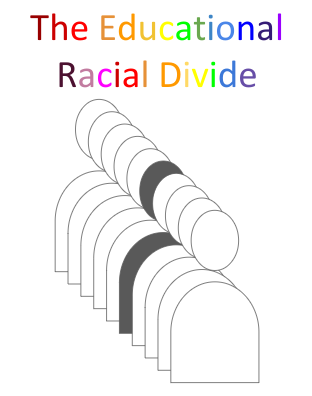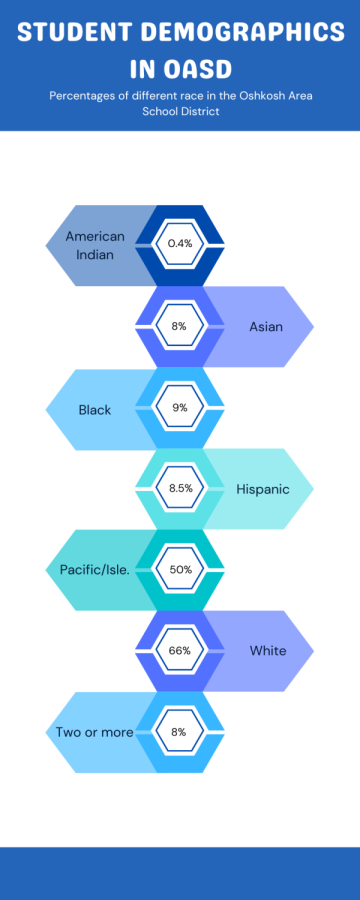The Educational Racial Divide
Only 10% of staff do not identify as white

May 9, 2023
Oshkosh Area School District (OASD) has a very diverse student population, as 35% of the student population are non-white. However, the staff population in OASD does not physically reflect the students’ demographics. Superintendent Bryan Davis acknowledges this discrepancy, which in part is why he asked the school board for a Director of Equity and Inclusion position.
According to statistics provided by Julie Conrad, Director of Curriculum and Assessment, around 90% of district staff are white whereas only 66% of the students are white. There is also a very obvious divide between the genders of teachers, around 65% of the staff population are women.
As shown in Figure 1, the white population has a larger percentage of students, but we can also see that we have a lot of students that are a different ethnicity and race.

Unfortunately, this figure only shows our student demographics. According to the Wisconsin Department of Public Instruction, only about 0.3% of the staff population are African-American. A little over 70% of the staff population are white women, and 20% are white men, meaning only about 10% of our staff population are people of different races.
This discrepancy is not an Oshkosh-only issue.
“It’s pretty common across the country, especially across Wisconsin,” says Davis, “But yes, there is a gap. Our staff is primarily white.”
This reality could limit the students in so many ways. According to Drexel University School of Education in an article titled, “The Importance of Diversity & Multicultural Awareness in Education,” it’s stated that when working and learning in a classroom with people from a variety of backgrounds and cultures, students gain a better understanding of the subject at hand. It also teaches students to use the strengths and their own point of view to contribute and create a diverse work environment.
“I think it depends on the student,” says Davis. “What students really need is ‘Identity Safety,’ so their identity is validated. Whether it’s race or religion or socioeconomic status or whatever the student brings as an identity into a classroom, it’s validated. They should feel a sense of belonging and they know that they can bring strength into the classroom. For students of color, having that validation in the form of a teacher of the same color or race in front of them helps deliver that sense of belonging and helps to draw them into the classroom.”
Junior Black Student Union (BSU) member Mercy Ajao has hopes that the staff population will eventually mirror the students proportionally, but she understands that it’s not their race that makes them good teachers.
“Some of the teachers don’t care about what the students are doing outside of school. It doesn’t bother me much. I don’t want them to be super involved in my life outside school. I feel more comfortable talking to the teacher that cares about my well-being or tries to know me about what I don’t understand and what I need help with,” says Ajao.
However, it’s not only about race. It is also important for genders to be well represented.
“I think gender, in many ways, does make a difference in basic connection. Teaching has historically been, especially at the elementary level, a pretty female dominated profession,” says Davis, “I think the ability to have more male teachers, to have that type of representation is important for many boys and their development.”
While race and gender reflections remain important and help students, they are not the only contributing factors to a student’s education. Having teachers who actually care about their students outside of school, can make students feel more welcome.
“I don’t really look at the race of the teacher. It’s more about how they present the material and their willingness to look at each individual’s needs,” says senior Vianna Dao.
Despite physical differences, students can still succeed at Oshkosh North with the staff here. But, in order to help students unlock their full potential so they can thrive, a more reflective staff my help with the lack of engagement and motivation, and may give students the role model they might not have outside of school.

